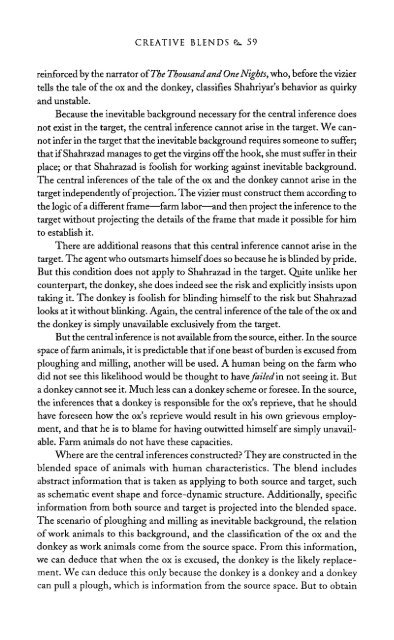The Literary Mind.pdf
The Literary Mind.pdf
The Literary Mind.pdf
You also want an ePaper? Increase the reach of your titles
YUMPU automatically turns print PDFs into web optimized ePapers that Google loves.
CREATIVE BLENDS 59<br />
reinforced by the narrator of <strong>The</strong> Thousand and One Nights, who, before the vizier<br />
tells the tale of the ox and the donkey, classifies Shahriyar's behavior as quirky<br />
and unstable.<br />
Because the inevitable background necessary for the central inference does<br />
not exist in the target, the central inference cannot arise in the target. We cannot<br />
infer in the target that the inevitable background requires someone to suffer;<br />
that if Shahrazad manages to get the virgins off the hook, she must suffer in their<br />
place; or that Shahrazad is foolish for working against inevitable background.<br />
<strong>The</strong> central inferences of the tale of the ox and the donkey cannot arise in the<br />
target independently of projection. <strong>The</strong> vizier must construct them according to<br />
the logic of a different frame—farm labor—and then project the inference to the<br />
target without projecting the details of the frame that made it possible for him<br />
to establish it.<br />
<strong>The</strong>re are additional reasons that this central inference cannot arise in the<br />
target. <strong>The</strong> agent who outsmarts himself does so because he is blinded by pride.<br />
But this condition does not apply to Shahrazad in the target. Quite unlike her<br />
counterpart, the donkey, she does indeed see the risk and explicitly insists upon<br />
taking it. <strong>The</strong> donkey is foolish for blinding himself to the risk but Shahrazad<br />
looks at it without blinking. Again, the central inference of the tale of the ox and<br />
the donkey is simply unavailable exclusively from the target.<br />
But the central inference is not available from the source, either. In the source<br />
space of farm animals, it is predictable that if one beast of burden is excused from<br />
ploughing and milling, another will be used. A human being on the farm who<br />
did not see this likelihood would be thought to have failed in not seeing it. But<br />
a donkey cannot see it. Much less can a donkey scheme or foresee. In the source,<br />
the inferences that a donkey is responsible for the ox's reprieve, that he should<br />
have foreseen how the ox's reprieve would result in his own grievous employment,<br />
and that he is to blame for having outwitted himself are simply unavailable.<br />
Farm animals do not have these capacities.<br />
Where are the central inferences constructed? <strong>The</strong>y are constructed in the<br />
blended space of animals with human characteristics. <strong>The</strong> blend includes<br />
abstract information that is taken as applying to both source and target, such<br />
as schematic event shape and force-dynamic structure. Additionally, specific<br />
information from both source and target is projected into the blended space.<br />
<strong>The</strong> scenario of ploughing and milling as inevitable background, the relation<br />
of work animals to this background, and the classification of the ox and the<br />
donkey as work animals come from the source space. From this information,<br />
we can deduce that when the ox is excused, the donkey is the likely replacement.<br />
We can deduce this only because the donkey is a donkey and a donkey<br />
can pull a plough, which is information from the source space. But to obtain















